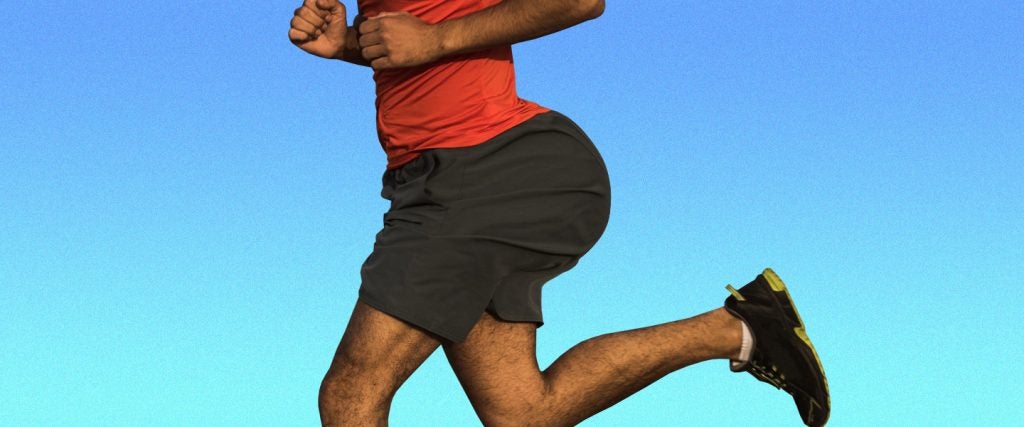Let’s pay a visit to two hypothetical gentlemen running at the track of their neighborhood’s high school on a Saturday morning: Flat Frank and Stacked Steve. When Stacked Steve saunters out onto the straightaway portion of the track, then sets his water bottle down to begin his warmup, he waves to Flat Frank, who has already been slowly and steadily jogging around the track for 20 minutes at a 15-minute mile pace.
“Hey, Steve!” shouts Frank. “Late to rise as usual! I’ve already got more than a mile in! Less than seven more to go!”
“That’s cool,” smirks Steve, as he cycles through some warmup jumping jacks and his meaty thighs bulge right through his Lululemon pants. “I don’t plan to be here all that long to be honest. Maybe half an hour tops.”
As Flat Frank commences his next slow-as-molasses trek around the track, Stacked Steve shoots off like a rocket, sprints a full 100 meters to the opposite end of the track, and then turns to commence a slow jog back to the other end. No sooner does Steve return to his starting position before he explodes into a dead run once more, covering another 100 meters before slowly jogging back to the starting line with his head hanging low with fatigue. Roughly 20 minutes later, Steve waves adieu to Frank and departs to get on with the remainder of his day.
In total, Steve covered 2,000 meters on the track — 1,000 of which were sprinted — in his Fartlek style of training. Meanwhile, Frank coasted to an additional one-and-one-thirds of a mile over that same period of time despite progressing through his training session at his plodding pace. Moreover, if Frank stays true to his word, he has another four-and-one-third of a mile to go before he throws in the towel.
Now, who do we expect will have the shapelier backside if their training routines remain consistent — Frank or Steve? Well, if the absurd names I gave these guys weren’t dead giveaways, the answer is clearly Steve, and the rationale behind it explains a lot about how muscles are developed in the body.
I don’t get it. Shouldn’t more running equal more muscles in your butt?
It’s true that running can undeniably help you develop ample muscles in your glutes, but there’s far more complexity to the process than what’s contained within this simple statement. There are several different styles of running, and much of muscle creation and growth is dependent upon which you adopt as your own. With that said, everything pertaining to muscle growth through running begins with your level of exertion.
Your body develops two truly distinct types of muscle fibers in response to training: type-1 and type-2. Type-1 muscle fibers are also known as slow-twitch muscle fibers, and they’re developed in direct response to endurance training. They’re crafted with fatigue resistance and posture maintenance in mind; this state is exemplified by their abundance of myoglobin, which enhances the capacity to replenish their oxygen. However, they’re relatively small, and don’t produce much propulsive force. This is the precise reason why Flat Frank can run effortlessly, and seemingly forever, yet he fails to generate any sizable muscles.
Conversely, type-2 muscle fibers are referred to as fast-twitch muscle fibers, and they’re produced by explosive movements — like your legs propelling your body forward at the fastest possible rate. They don’t possess nearly the same amount of myoglobin as the slow-twitch fibers, and they become fatigued very rapidly. Stacked Steve was training these specific fibers during the all-out sprinting segment of his Fartlek session, but he was also taxing his type-1 muscle fibers during the slow-jogging portion of his training. As a result, his backside reaps the benefits of the combination of the two.
Does this mean running will tone my glutes better than weight training?
No chance.
Even if you have the perfect set of genetics to assist you — including the most advantageous hip insertion points and bone lengths — there’s almost no chance that your glutes will respond better to any combination of running than they would to heavy resistance training that targets them directly. So if your only interest in running stems from your belief that it will bless you with a bubble butt, you should repurpose at least some of that treadmill time to any of the many different ass-blasting, load-bearing movements, like squats, hip thrusters, deadlifts and lunges.
Otherwise, you’re not exactly running away from a thicc ass, but you’re certainly not sprinting toward it either.

